Nico Vega and Oh No Fiasco Deliver Hard-Hitting Rock at Nashville’s Exit/In
August 25, 2013
Nashville’s the Exit/In, a classic yet almost easy to miss venue, recently played host to Los Angeles band Nico Vega, an up-and-coming powerhouse of a band known for their mix of musical elegance and gritty energy. The opening band, Oh No Fiasco, with whom Nico Vega share a label, combine alternative rock roots with a sometimes cutesy punk flair.
Oh No Fiasco opens, immediately setting the bar for showmanship. The band’s lead singer, Lindsey Stamey, is a complete fireball on stage, melting faces right off the crowd as the band plows full force through the first song of their set. The stage is completely electric as the five members of the band bounce, dance, and enjoy what they obviously love to do. Theatrics are integral to the band’s performance, exemplified in moments where the band’s drummer spits water onto the drums while playing, showering himself and the stage, or when the keyboardist places a small keyboard on another member’s feet and plays through the remainder of the song.
Oh No Fiasco ends their unfortunately short set with Stamey singing from the balcony seating of the venue. The group is an obvious crowd-pleaser as fans on the floor show their affection and admiration as she swaggers on through.
Following Oh No Fiasco, Nico Vega takes the stage. Lead singer Aja Volkman approaches the mic, looping vocals in harmony as the band forms onstage. The performance is very personal, humble even. For a band that’s known for exemplifying a rebel spirit, they’re all terribly mild-mannered.
Not to say they can’t kick out a jam like no other.
Volkman’s vocals are high-flying, soulful, and smooth as silk one minute, then growling and full of all the raw passion you’d expect from someone who stands on a steel barrel and sings while beating the sides like a drum. Her showmanship onstage is energetic, swaying and dancing from side to side, hands raised or slapping cymbals of the band’s drum set. Her passion and feeling for the music itself is soul-touching on a real level.
Not surprising coming from a band that considers itself more a way of life than just an expression of musical talent.
The set features songs from the band’s self-titled album of 2009 and their recently released EP, Fury Oh Fury. The band opens with “Lead To Light,” leading into “Fury Oh Fury” and “Lightning,” all songs from their current EP.
In the midst of the fury and passion comes the song “Wooden Dolls,” a slow, expressive tune about the unity of people and also the barriers we create, all sung from atop the aforementioned steel barrel onstage. Volkman’s sincerity is clearly visible in her presentation of the lyrics. It’s pleading, hopeful, and beautiful in every way.
One of the band’s more easily recognizable songs, “Gravity” begins slow with floating guitar and ethereal vocalization, but suddenly exploding into life as the song picks up pace, delivering hammering drum beats alongside Volkman’s vocal power as she sings about the oppression of conformity.
The set closes with the band’s powerhouse anthem: “Beast.” Featured in the trailer for the video game Bioshock Infinite and also a trailer for film Pacific Rim, this song alone is at least partly responsible for the band’s recent success, and it’s very clear why.
The song begins with a pounding, militant drum and heavily distorted guitar. The guys and girls of Nico Vega know what this song means for listeners, fan or otherwise, and they deliver on every level. It’s everything the band is about, rejection of oppression and a demand for unity amongst all people against the “beast of America.” That passion is palpable, almost a lusting passion for defiance against whatever it is that holds us down and forces its will on us.
It’s the perfect note to end on for a band with their level of conviction and proof that Nico Vega is everything that’s still right with rock and roll today. –Jordan D. Frye, Contributing Editor
Headlight On A Northbound Train: McCartney, AmericanaramA, Deadheads, and Me
July 10, 2013
My music fandom began sitting on the carpeted floor of a middle-class house in the suburbs of Cleveland, Ohio. My parents owned a record player and a handful of albums, among them The Beatles’ Revolver and The Freewheelin’ Bob Dylan. Much like the scene in Almost Famous when the protagonist’s sister turned her younger brother onto her tunes, the needle touched vinyl, and pretty much everything changed. By junior high, the music of The Beatles and Dylan saturated my psyche and shaped my identity.
At the time, the likes of Simon & Garfunkel, The Rolling Stones, and Led Zeppelin also seared my ears and soothed my soul. Rock ‘n’ roll inspired all-night adolescent airband artistry and class presentations on the poetics of the Don McLean song “American Pie.” Tragedies like the respective deaths of John Bonham and John Lennon jolted our reality. We discovered that Bonham died when we went to school one day and had to ask, “Why are all the burnouts crying?” But of course when Lennon died, everybody cried. Like the McLean song prophesied, we had many, many days when the music died.
In my high school years, punk, new wave, and of course the jubilant jangles of REM and the angelic anthems of U2 put some distance between me and 60s-70s classic rock, but I grew up in close enough proximity to the actual hippies and stoners that I would always suffer an epic kinship to these transformative periods of American popular music that still impact us today.
With all the burning-out and fading-away and ultimate fatality, it’s no short miracle than any of the greats that all but danced down the apocalypse still survive this far into the 21st century, to this post-2012 period of popular musical renaissance and revival. With all this in mind, I feel such gargantuan eardrum-obliterating gratitude in relishing the immediate memories of the fantastic fact that in June 2013, in a span that stretched 16 days between two amazing weekends in Tennessee, I would see Paul McCartney at Bonnaroo and Bob Dylan on the Nashville riverfront. I’m likewise blown-away by some of the other bands we’ve been able to hear, the peers for my ears, who along with the headliners create bookends of beauty and blessing, of soggy singalong eyes and goosebump-inducing bliss.
Frankly, I cannot hype enough hyperbole to express the hopeful holiness, mix enough metaphors to convey the meaning, or raise high too many mocktails to celebrate the recently passed occasions. Frankly, I would feel too selfish to savor this if I didn’t have the chance to suggest you catch Dylan or McCartney who are both still on tour, if the other peers-for-the-ears were not still hitting up festival-after-festival for the rest of the summer. As endless rains fall on my 4th of July holiday weekend, I scribble this testimony in hopes that someone might get a nibble of the goodness I’ve already experienced and perhaps seek out some of these shows the rest of the summer. As I ponder some of the more painful and plainly ludicrous prices that others have paid for the privileges I enjoy, I admit that I am most patriotic when it comes to our popular common culture, from sport to movies, but I am a patriot when it comes to music most particularly.
Since The Beatles official touring ended in 1966 and since Lennon died in 1980, I don’t think I’ve ever really wrapped my mind around the sheer significance of a Paul McCartney tour. Sure, we hear snippets of his later work and lots from the Wings period, but at root, we’re not hearing McCartney cover The Beatles; McCartney is a Beatle. Here in my mid-40s, more than a decade into the new century, I am watching a man in his 70s, looking and sounding sharp and charismatic do nothing shy of reclaiming and reviving with sonic groove and grace the greatness of The Beatles.
We hear love songs that kindle every feeling of passion I have for my partner dancing beside me and our world living and dying around us. We hear a song of letting-go like “Let It Be,” and for those few minutes we actually obey and let go; we let, it, be! Psychedelic moments surge forth from the tunnel of memory into the sober mess of the present, and we get crazy happy hearing “Helter Skelter” or “Being for the Benefit of Mr. Kite!” Throughout McCartney’s set at Bonnaroo, I had several delightful moments where disorientation met déjà vu, and I felt myself wonder, “Is this even happening?” Similar sensibilities of timely and timeless wonder would return in a little over two weeks at the Nashville riverfront.
Most people benefit from an extracurricular passion or hobby or two—or in my case several. As much as I have hoped to enhance and enjoy the avocation of music fandom, at times, I almost abandoned it or even worse sabotaged it. At one point, I almost lost track of the best tracks from sheer necessity and lack of time or lack of money. But then it gets worse, at the very time my fandom had rekindled with verve and passion. Like too many before me and too many after me, I tried to spice up the musical listening and dancing experience with drugs and alcohol. This resulted in bad trips, drunken mistakes, and general stupidity—all in pursuit of a quicker fix and higher high. The Americanarama festival that’s now on tour brings together artists for whom, all at different times, I have an acute recollection of almost wrecking the cosmic connection that their music brings for me.
Spanning the years from 1988 to 2008, from the days of youthful entheogenic experimentation to the seemingly endless nights of excessive intoxication, I occasionally overestimated my abilities and my tolerance and seriously compromised my boundaries and my values. Let’s just say I’d undermined otherwise potentially perfect nights with The Grateful Dead, My Morning Jacket, and Bob Dylan, ruined not so much for anyone else, but trashed for myself. Yet on the last day of June, I had an opportunity for musical redemption, getting high on the songs and on life, on enjoying the modesty and the clarity of not being “that guy” at the show.
Former Dead and current Furthur guitarist Bob Weir performing solo begins the itinerary, and we got to the show early enough to catch his set. In fact, we could hear Weir’s soundcheck as we lined-up outside the venue and were satisfied to get a spot up-close by the stage—even if the ground, instead of a carpet of grass, was merely a fresh layer of mulch, the kind that smells just a little too fragrant, too much like, well, mulch. Other reports have it that the sound quality suffered towards the middle and back of the field, but we were glad to be so close and not need earplugs to enjoy the show.
After opening with a Ratdog track that I enjoyed but didn’t recognize on electric guitar, Weir followed on the acoustic with the Dead standards “Loose Lucy” and “Friend of the Devil.” The pearls of rock wisdom that lit up his lips and fell from Weir’s lyrics were simple yet prophetic and paradoxical in the opening song: “If we don’t believe together, we might just cease to be”; and the final refrain “Dreams are lies, it’s the dreaming that’s real.” Of course this rings authentic to me, for whom the drunken dream was a lie, but dreaming a sober psychedelic experience suddenly became real!
My rekindled Dead interest has increased over the last few years as I have rediscovered their music without the aid of any of my former chemical crutches. Music that I once presumed required a listener to be intoxicated has opened itself up to me in new and magical ways completely clean. Last summer, I missed a Furthur show that I’d planned for—in order to attend a funeral; I still have hopes to catch one before too long. I cannot help but admitting that learning Bob Weir would be part of this AmericanaramA event felt like some beatific cosmic payback for doing the right thing last year.
After covering the Bob Dylan track “Most of the Time,” mentioning that we wouldn’t hear it later, Weir closed his too short set with a track he co-wrote called “Cassidy.” The lines invoke endless youth: “Ah, child of countless trees. Ah, child of boundless seas.” The stories behind the song are both a charge of hope for a young child born to the Dead tribe back-in-the-day and a tribute to the late Neal Cassady, the reckless and impetuous idol of Ginsberg, Kerouac, and the Beat Generation. The old me was like Neal Cassady, one who sought a false boundlessness of hedonistic debauchery, but the new me might be more like a reborn child who sees countless blessings in a sea of hopeful faith and fidelity, an inner freedom to which the many wildly-winding and rocky-rocking roads finally led me.
I must say that the time between sets at shows can grind down my serenity and patience. Whether out at the food lines and bathroom lines or standing or sitting simply waiting, the minutes that usually fly by just drag on. This time we brought a deck of cards to pass the time as we sat on our now mulch-soiled blanket. But we could barely finish one hand of rummy before My Morning Jacket stormed the stage to open with a campfire anthem that more often closes a show, “Wonderful (The Way I Feel).” The ensuing 75 minutes flew by, with many of our absolute favorite Jacket songs and some surprise back-catalog nuggets. The whole band was tight, animated, on. Something about seeing them in daylight from so close to the stage, especially before the people around us were totally trashed and pushing past us, made this a perfect set for me.
In the midst of all this gloriousness, Bob Weir joined the group on stage to perform two Dead numbers. The first song they chose was “Brown Eyed Women,” the lyrics for which I could not get out of my head for days following the show, and these filled me with wicked irony. Here I am cold sober singing in my head the sloppy refrain, “Brown eyed women and red grenadine/the bottle was dusty but the liquor was clean.”
It’s a great comfort to me that another Dead song called “Wharf Rat” is about a down-and-out drunk and that this tag has become the moniker for the Wharf Rats, the seminal clean-and-sober fan community that’s created a far-flung fellowship and meeting support structure for Deadheads who voluntarily abstain from alcohol or drugs.
All this said, the Grateful Jacket ranks as one of my greatest concert experiences ever, just those two songs, almost like it was destined to happen since before our MMJ boys were even born. During some of the jammier moments, the way the rest of the Jacket members focused their attentions and intuitions on Weir was just mindblowing. The almost acapella harmonies at the end of “I Know You Rider” with Bob, Carl, and Jim singing to the center of my gut, that was so phenomenal that I just want to cry thinking I actually got to see it! Ever since I first heard it some 25 years ago, the line towards the end of the song—“I wish I was a headlight on a northbound train”—has conveyed such hope for me; others have been that light for me, and we can be that light for others.
At this point, AmericanaramA could be called AmericanaJamma if you ask me. Smiling, I went from “wow” to just more—wow wow wow! The collaborative synchronicity and spontaneity continued during the Wilco set when Weir returned for two more songs, first the Dead’s “Bird Song” followed by a face-melting and sheer shredding rendition of “Tomorrow Never Knows” by the Beatles. For all their musical and lyrical inspections, to all the setlist-shapeshifting with each night a different confection, My Morning Jacket and Wilco are wonderful heirs to what the likes of Dylan and the Dead have done for American music.
This life has been a journey between polarities, from the desperation found in “Friend of the Devil” to the grace of Jeff Tweedy opening with “Blood of the Lamb,” Woody Guthrie lyrics set to Wilco music. My past experiences of Wilco live had been daytime sets at Bonnaroo where they were a bit woozy for me, even sleepy, but not that night, that last Sunday in June.
Neither Wilco nor My Morning Jacket needs to take the opening spot on a tour, but AmericanaramA conceives itself more as a concept roadshow, of which Dylan has participated in many, like the fabled Rolling Thunder Revue. The crowd at Nashville spanned the generations. Rather than a crew dominated only by old Deadheads and Dylanologists, the field was filled with lots of younger folks, including those who seemed to know most every Wilco or Jacket song.
By the time Dylan took the stage, we were already full to overflowing from the first four hours of the night. To see Dylan in his proper context is to approach him as everything we’ve heard and read and nothing at the same time. Dylan destroyed expectations when he went electric, when he went for Jesus, when he refused to be a spokesman for whatever generation and instead let his song-poems speak for themselves.
Dressed in a big white hat and impressive white jacket, growling and spitting his verses, Dylan was just another white MC dressed-in white and laying his vision of the world down on the greasy backing track of the white man’s blues.
Newer tracks like “Early Roman Kings” could either invigorate or indict the image of power that Dylan undermines even as he takes advantage of it. Looking around the audience, we are all benefactors of that vision, where we’re both critic and cynic and innocent psalmist all at the same darn time. Seeing his swagger sinks deep, because by recalling the badass he once was he also reminds us that this elegant grizzly elder is more badass than many of his contemporaries could ever be.
The opening track of the main set is “Things Have Changed,” as if to rub-in and reiterate that this isn’t our freewheelin’ folk singer that I first discovered on vinyl. He closed that set with “All Along The Watchtower,” and we danced near the back of the field, having moved just two songs ago from our spot up close, savoring the view and lights. The lyrics of “Watchtower” walk to the center of me, for this speaks a story from which I am now at a fragile but triumphant distance. There was a time when I could “get no relief” not even from drinking wine, when everything seemed false, when I felt trapped by fate, when the hour most definitely was getting late!
Speaking of late hours, it was now just past 11, and we left before the encore, to follow our own headlights on an eastbound itinerary for a morning that would get here too soon. In the car, I played a version of “Blowin’ In The Wind” from the Rolling Thunder Revue, with Joan Baez joining Dylan on vocals. My sweet wife said, “I wish he had played this song,” suggesting the emotional power would have brought the whole place to tears. “He never plays this song live,” I retorted, with an explanation of his refusal to be “that Dylan” just for us fans. Little did I know then that his gospel friends from his born-again period, the McCrary Sisters, had just joined him onstage for the rare rendition of “Blowin’ In The Wind.”
I can’t undo leaving early or deny that Dylan will probably always remain just beyond our grasp of who we think Dylan is. Americanarama is still on tour as of this writing, and I imagine that something freewheeling and rolling and thunderous in the spirit of American music awaits every fan with tickets to catch this show, sober or not, with a surprise encore like Nashville or with the “Ballad of a Thin Man” that most crowds get.
Something is happening. And we don’t know what it is. But we’re going to check it out anyway. And keep checking it out as long as our ears and hearts cooperate. –Andrew William Smith, Editor
Pictures by Andrew William Smith
For AmericanaramA tour dates, go here: http://www.bobdylan.com/us/upcoming-dates
For Paul McCartney tour dates, go here: http://www.paulmccartney.com/live/27468-out-there
Listen to Bob Weir with My Morning Jacket from the Atlanta show: http://snack.to/ahp070es
The Vibrating Emotions of Dinner and a Suit, live in Nashville
March 14, 2013
Nashville continues to remake its music reputation for the better. Nashville’s talent pool remains enormous, and we witnessed this again as local four-piece rock/pop outfit Dinner and a Suit recently performed at the Cannery Ballroom in Nashville.
The simple-looking band launched immediately into a high flying, high energy performance that literally shook the floor beneath our feet. The upbeat set made us want to move, dance, and sway with the crowd. Powerful emotions pack the songs: the longing, the hope, the confusion. Put plainly, they’re just really good.
Vocalist Jonathan Capeci, guitarist Joey Beretta, bassist Anthony Genca, and drummer Drew Scheuer settled into a groove with the floodgates open and the sound pouring into the room, covering everything and everyone. Too often, intensity and energy mean sacrificing quality in the songs, but for Dinner and a Suit no such loss transpires. Each song in their set revealed a truly respectable amount of dexterity in their performance.
The performance was just so great overall, but every show does have its moments of sublime beauty. The fourth song in their set, “Where We Started,” deals heavily with hope and forgiveness, combining the beauty of a Coldplay-esque piano ballad with jazzy drum flairs, interjected by moments of heavy beats and rumbling guitars. The combination doesn’t feel forced in any sense, and the emotion in Jonathan Capeci’s voice shines through.
So much of Dinner and a Suit’s music brings messages of hope in the face of change. Their songs are both tempered and embellished by the emotion that inspires creation, and the emotion drives the band in their live performance. The evidence is never clearer than in their performance of a song titled “It’s Not Over.”
The song began with the high-ringing sounds of Joey’s guitar as Jonathan came in on the piano. Soon enough, the crash of the drums and thump of the bass made tables and chairs vibrate across the floor as Jonathan bounced up and down, his hands crashing on the keys of his piano while he wailed into the microphone. It’s really not often that you see any artist rock out as much as Jonathan does on a piano, and again, the skill with which they all come together on the song is just incredible. Flawless isn’t a safe word to use for anyone, but these guys certainly come close.
Just as soon as they start, they are finished, and again, the humility that can so take you by surprise steps in again, as Jonathan finishes the set by approaching the mic, delivering a quick, “God bless you, have a good night,” and stepping out of the spotlight. For a group with so much talent and reasons to be cocky, the openness with which they approach their audience is welcome. Besides, there isn’t enough space in the room for a big ego with a sound as big as theirs. – Jordan Frye, Contributing Writer
Dinner and a Suit are currently on tour, so if they come through your neck of the woods, drop in and give them a listen, or check them out online at Facebook.com/dinnerandasuit.
Mumford & Sons Return to Brooklyn with Unabashed & Very Welcome Sincerity Intact
February 10, 2013
Bleeding-heart sincerity is uncomfortable for many people. Makes a weaker person turn away, ashamed for the feeler. Second-hand embarrassment and all that. As if honesty is something to be ashamed of. Be it in a moment of unabashed joy, unimaginable pain or just looking deep into someone’s eyes to deliver an apology or hard-to-swallow truth. It’s easier to turn away and pass judgement instead of attempting to understand. Or respect the torrent of emotion and tribulations involved.
We’re all just trying to be better people, sincerely. Or be better at being people.
I first laid eyes on Mumford & Sons in October 2009 when I was one of the few and first American reporters tasked with covering them during the annual CMJ Music Marathon. Their indie buzz was positive (and not divisive) then, and my friend Fred (who accompanied me to the show) corroborated their cachet with a resounding thumbs-up. It had been an important band for he and a former girlfriend, and he was certain I too would walk away a believer.
The Mumfords shared a packed bill that night at the Blue Flowers showcase at the Music Hall of Williamsburg with hypey also-rans The Temper Trap and Golden Silvers. They opened with eponymous album title cut “Sigh No More” and 10 seconds in, I was in tears. I looked at Fred and said, “this is devastating.” I would go on to opine of the show in my review: “…from first blush and foot stomp to the last joyful harmony, an undeniable, unimaginable victory.” Also tellingly, I said this: “Fans of Damien Rice, the Avett Brothers and BRMC’s ‘Howl’ will freak if they haven’t done so already. My larger hope, of course, is that everyone else will, too. That’s right: Mumford and Sons is your new band to believe in, kids.” “Little Lion Man” and “The Cave” would own millions of brains (including many of my dearest friends) just months later.
In February of the following year, in the dead of winter, I was confirmed to design and manage my very first photo shoot with the band at a Victorian-themed bar in Union Square. A brilliant photographer friend of mine agreed to take it on, and the bar confirmed they’d allow us use of the back portion of the place for 20 minutes so the guys could have some peace. No rest for the weary gentlemen of the road, unfortunately, and myriad reasons prevented them from making their initially scheduled flight, and thusly the whole production was cancelled on the day of the shoot. The lighting, the mirrors, the antique furniture, it had all lined up perfectly. All it needed were four English blokes who were just starting to know what royalty checks look like. That night, however, the show would go on at the venerable Bowery Ballroom — their first headlining stop in Manhattan — where they played a barnstormer of an album-release party. Gone forever were the days when you could happen upon ruddy-faced Hemingway-esque lead singer Marcus Mumford outside the front door of the venue next to the band’s gear truck, laughing broadly, enjoying a smoke and beer, and high-fiving anyone who dared approach with well-wishes.
To wit, as I reported then: “I’ve watched plenty of bands achieve ‘full flight’ before. That’s what following U2 around the country for years and admiring Fanfarlo during CMJ will earn you. But the fiery, banjo-wielding Mumford & Sons showed the capacity crowd truly something special last night, and the crowd – a foot-stomping, hands-in-the-air, doin’ a jig, hugging your neighbor mass of winter coat-wearing strangers – sang back every word. ‘Awake My Soul’ became less an album track, and more a pathos as the night wore on.”
Much has been derisively said about the Mumfords’ “alt-folk” tent-revival schtick. As if was actually a falsehood. A come-on. A bit of pretend. As if they were trying to insert themselves into a scene they categorically and factually had no part of, like Vanilla Ice in Miami, purporting to be some kind of banger. Just because they were well-educated and London-based and not rural-dwelling sheep herders, clearly this wasn’t an honest band. But see, the discerning music lover is smart enough to sniff the shit from the soap. Watching the other audience members have profound reactions while taking in Marcus and the boys was no lark — this was a band doing something important, much-needed and significant. Sounding and answering their own clarion call with the fury of an army armed with little more than banjos, dobros, elbow grease and a lot of passion and sincerity.
Sure, audience members can be given to spontaneous celebratory noodling and hoedowns at a Mumford show, just as industrial fans have the Pavlovian desire to slam against each other. This isn’t an emotional display to be critical and suspect of; I reserve much judgement for a human being who can side-eye another human being wrapped up in the unbelievable joy that washes over you when a turn of phrase fixes your heart, leading your outstretched arms to signify “FINALLY,” because someone had the big beautiful gall to say it. Whatever IT is for you.
Last night at the Barclays Center in Brooklyn, I was blessed to witness FINALLY on a grand, arena-sized scale as thousands sang along to “Babel” (“Cause I’ll know my weakness, know my voice/And I believe in grace and choice”), “Thistle and Weeds” (“Plant your hope with good seeds/Don’t cover yourself with thistle and weeds”) and “Awake My Soul” (“In these bodies we will live, in these bodies we will die/And where you invest your love, you invest your life”) among other joyfully rowdy tunes such as ” I Will Wait,” “Lover of the Light,” ubiquitous wunderkind hit “Little Lion Man” and “Roll Away Your Stone.”
We’re all just trying to be better people, sincerely. Or be better at being people.
I don’t know about you, but lately, I’m tired of hiding. And since Hurricane Sandy wrecked my life up something fierce in late October 2012 (I remain displaced from my downtown Manhattan apartment as I write this), I’ve had no choice but to be alternately sincerely troubled and sincerely hopeful, with sometimes disastrous results the last four months. While looking out at the thousands with arms outstretched in their own private Idahos of FINALLY last night, I closed my eyes, sat still as a rock, and just listened to the newly impassioned soulful voices around me. Everyone has their own Sandy.
Excavation is exhausting, but one of the most necessary tasks we have inherited in this mortal coil. How else can you get to the heart of any matter or complication if your knee-jerk reaction is to turn away from the mud that comes with an uncomfortable truth? This is the question that Mumford & Sons seek to answer, sincerely. –Carrie Alison
Carrie Alison is a former editor, music journalist and publicist. She lives in New York City.
Phil Keaggy: “Yes, There is such a note.”
February 10, 2013
Judging by the size of the crowd in the back room performance area of Nashville’s World Music store, it’s hard to believe that the man taking the stage is a seven-time recipient of the GMA Dove Award for Instrumental Album of the Year and twice nominated for a Grammy Award for Best Gospel Album. The seating is limited to sold-out crowd of 100. Performing his one man show is Phil Keaggy, Christian musician and undeniable legend of guitar.
To say that Phil Keaggy is a good guitar player is something of an injustice to the man’s ability. He is commonly ranked among the top three finger-style and finger-picking guitarists in the world, but that is only a portion of what makes the man so incredible to listen to and to watch.
Phil took the stage, wasting no time of the hour and a half he planned for his set, jumping right in to a frenzy of acoustic guitar that can only be described as awe-inspiring. His finger work is almost difficult to comprehend as he strings notes together in a delicate series of tones that resonate to fill the entire room.
The stage in front of him is filled with pedals, which he continually plays with, using loops and delays to create what any rational person would assume is a quartet of guitarists playing together. Phil used his setup to create rhythm behind his playing, throwing loops of harmonics and pseudo-bass lines into the mix, and even shouting and singing into the body of his acoustic, laying tracks of his voice down with the rest to create his own harmony with. He did this without missing a single beat and kept a smile on his face through the entire show. It’s refreshing to see any performer who seems to enjoy their work quite as much as Phil Keaggy does.
One of the incredible things about Keaggy’s performance is his transformation of a cover. Most artists are well-accustomed to spinning their own take on a famous song, but Keaggy goes far beyond that. Half way through the set Keaggy calls a friend, Mike Pachelli, to the stage to perform a few songs together, leading in with a cover of Bob Dylan’s ‘Make You Feel My Love.’ It is truly astonishing how Keaggy can take something as comparatively simple as a Dylan song and turn it into something so rich and layered. He utilized the skills and techniques he is known for but did so in such a way that he didn’t overpower Pachelli’s playing. The two blended their sounds together to create something new and complex, but simultaneously recognizable as the original song.
There is a noted playfulness as Keaggy continued the performance. He launched into a cover of Bonnie Raitt’s “Take My Love With You,” which he prefaced by saying he had “learned this yesterday,” expressing, tongue-in-cheek, that at his age it takes a little while to learn a song, earning ripples of laughter from the audience. His performance of the song, much like his cover of Bob Dylan, was unique, flawless, and showed no indication of unfamiliarity with the song whatsoever. The same unique exploration of the sound was present in a later cover of George Harrison’s “Here Comes the Sun.”
There is emotion in the sound that Keaggy creates. He prefaced a later song, entitled “Let Everything Go,” by telling a short anecdote about riding his bike and chasing hot air balloons on a sunny day. As the last notes of the symphony he alone created floated through the air, it’s almost impossible not to feel as though you yourself are standing in the sun, watching those balloons float away into the sky. It’s an awe-inspiring experience, to say the least.
Time flies by when you’re watching someone as enthralling as Keaggy perform. Before we know it, 90 minutes has passed and the set ends. Phil approaches the mike, thanks the audience for attending, and makes a simple request that the crowd help support the Blood Water Mission in their efforts to combat water crises in Africa by buying an album, from which a portion of the sales will go directly to help missions overseas.
Naturally, none of the audience wants to leave without hearing more. The performance is personal, and when the request is made, Phil graciously accepted and approached the mic again to perform a song titled “True Believers.” There is nothing held back. He purposefully and wonderfully combines trapping, high-flying moments and more traditional acoustic styles. Coming back again to his light-hearted nature, on the last chord of the song, his fingers stretched like a circus contortionist over the frets of the guitar, he looked up at the audience, smiled and said, “Yes, there is such a note,” and finished.
At his heart, Phil Keaggy is purely a man of God. His humility onstage and simple enjoyment of the sounds he can make are inspiring enough. It’s fair and fitting to call his sound ‘divine.” If there is any proof that there is a God, it’s that someone so imbued with the message he believes can create something so beautiful as a result. Maybe God decided it was high time to break into the music business. –Jordan Frye, Contributing Writer




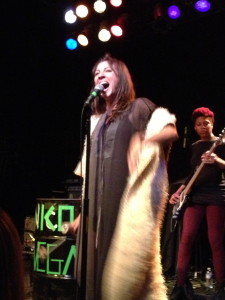
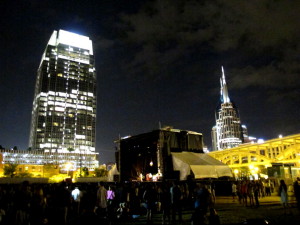
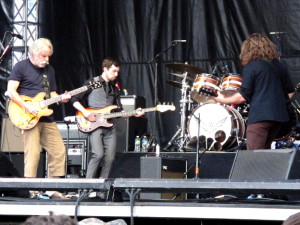
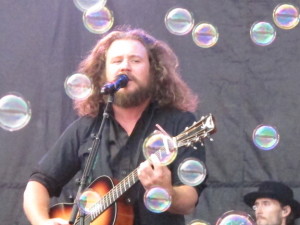
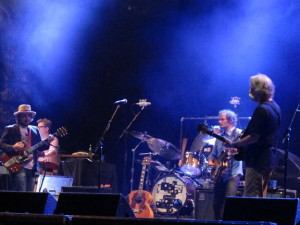
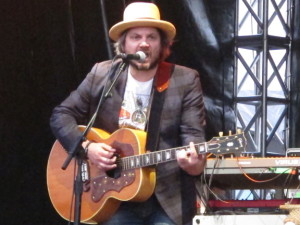
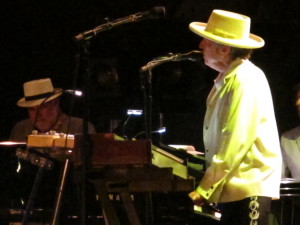
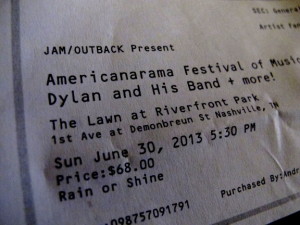
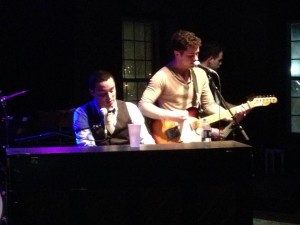

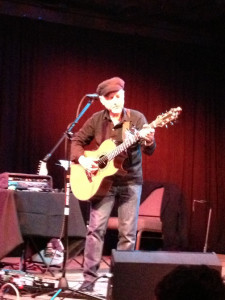
Recent Comments